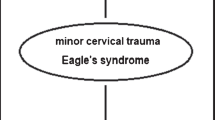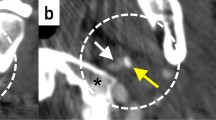Abstract
Objective
The calcification of the stylohyoid chain (SHC), elongated styloid process (SP), larger SP’ angle and its shortened distance of cervical internal carotid artery (CICA) are risk factors for bony compression and the stylocarotid syndrome.
Methods
3D-CTAs of 125 patients were analyzed in terms of the SP length, its angulations, type of the SHC and relationships of its proximity to the CICA.
Results
Elongated SP was observed frequently both in females (47%) and males (55%). The mean distance of the CICA to the SP was calculated as 8.2 ± 3.3 mm. This short distance between the CICA and the SP was observed more frequently in males (28.1%) and females (10.7%). The anterior and medial angulations of the SP were calculated as 71.2 ± 4.3°, and 57.3 ± 9.3°, respectively. In the present study, the SHC was determined as normal SP (54.2%), absence of the SP (1%), duplication of the SP (1%), elongated SP (26%), complete ossification of the SHC (1%), segmentation of the SHC (9%), fracture of ossification of the SHC (1.6%) and pseudo articulations of the SHC (5.6%).
Conclusion
3D-CTA was the most appropriate radiological investigation analyzing and measuring SHC (elongated, larger angle, shorter distances with CICA) and identifying types (duplicated, segmented, complete and fractured) resulting from pressures on the CICA. Our study also revealed the pressure on the artery not only arose from the tip of the SP but could also result from types stretching over the artery wall. In those specimens, there is a higher probability of formation of the stylocarotid syndrome due to the long-term pressure on the sympathetic chain around the CICA.





Similar content being viewed by others
References
Alpoz E, Akar GC, Celik S, Govsa F, Lomcali G (2014) Prevalence and pattern of stylohyoid chain complex patterns detected by panoramic radiographs among Turkish population. Surg Radiol Anat 36(1):39–46. doi:10.1007/s00276-016-1624-y
Bagga MB, Kumar CA, Yeluri G (2012) Clinicoradiologic evaluation of styloid process calcification. Imaging Sci Dent 42(3):155–161. doi:10.5624/isd.2012.42.3.155.
Balcioglu HA, Kilic C, Akyol M, Ozan H, Kokten G (2009) Length of the styloid process and anatomical implications for Eagle’s syndrome. Folia Morphol 68:265–270
Basekim CC, Mutlu H, Gungor A, Silit E, Pekkafali Z, Kutlay M, Colak A, Ozturk E, Kizilkaya E (2005) Evaluation of the stylohyoid process by three-dimensional computed tomography. Eur Radiol 15:134–139
MacDonald-Jankowski DS (2001) Calcification of the stylohyoid complex in Londoners and Hong Kong Chinese. Dentomaxillofac Radiol 30(1):35–39
Onbas O, Kantarci M, Murat Karasen R, Durur I, Cinar Basekim C, Alper F, Okur A (2005) Angulation, length, and morphology of the styloid process of the temporal bone analyzed by multidetector computed tomography. Acta Radiol 46:881–888
Piagkou M, Anagnostopoulou S, Kouladouros K, Piagkos G (2009) Eagle’s syndrome: a review of the literature. Clin Anat 22(5):545–548. doi:10.1002/ca.20804 (Review)
Ekici F, Tekbas G, Hamidi C, Onder H, Goya C, Cetincakmak MG, Gumus H, Uyar A, Bilici A (2013) The distribution of stylohyoid chain anatomic variations by age groups and gender: an analysis using MDCT. Eur Arch Otorhinolaryngol 270(5):1715–1720. doi:10.1007/s00405-012-2202-5 (Epub 2012 Oct 7).
Kim JE, Min JH, Park HR, Choi BR, Choi JW, Huh KH (2012) Severe calcified stylohyoid complex in twins: a case report. Imaging Sci Dent 42:95–97. doi:10.5624/isd.2012.42.2.95 (Epub 2012 Jun 25)
Kosar MI, Atalar MH, Sabanciogullari V, Tetiker H, Erdil FH, Cimen M, Otag I (2011) Evaluation of the length and angulation of the styloid process in the patient with pre-diagnosis of Eagle syndrome. Folia Morphol 70(4):295–299
Nakamaru Y, Fukuda S, Miyashita S, Ohashi M (2002) Diagnosis of the elongated styloid process by tree-dimensional computed tomography. Auris Nasus Larynx 29:55–57
Oztas B, Orhan K (2012) Investigation of the incidence of stylohyoid ligament calcifications with panoramic radiographs. J Investig Clin Dent 3(1):30–35. doi:10.1111/j.2041-1626.2011.00081.x (Epub 2011 Aug 5)
Cullu N, Deveer M, Sahan M, Tetiker H, Yilmaz M (2013) Radiological evaluation of the styloid process length in the normal population. Folia Morphol (Warsz) 72(4):318–321
Nayak DR, Pujary K, Aggarwal M, Punnoose SE, Chaly VA (2007) Role of three-dimensional computed tomography reconstruction in the management of elongated styloid process: a preliminary study. J Laryngol 121:349–353
Colby CC, Del Gaudio JM (2011) Stylohyoid complex syndrome: a new diagnostic classification. Arch Otolaryngol Head Neck Surg 137:248–252. doi:10.1001/archoto.2011.25
Koivumäki A, Marinescu-Gava M, Järnstedt J, Sándor GK, Wolff J (2012) Trauma induced Eagle syndrome. Int J Oral Maxillofac Surg 41:350–353. doi:10.1016/j.ijom.2011.12.031 (Epub 2012 Jan 12)
Kubikova E, Varga I (2009) A case of extremely long styloid process without clinical symptoms and complications. Clin Anat 22:865–867. doi:10.1002/ca.20782
Okur A, Ozkiris M, Serin HI, Gencer ZK, Karaçavuş S, Karaca L, Kantarcı M, Saydam L (2014) Is there a relationship between symptoms of patients and tomographic characteristics of styloid process? Surg Radiol Anat 36(7):627–632. doi:10.1007/s00276-013-1213-2
Oztunc H, Evlice B, Tatli U, Evlice A (2014) Cone-beam computed tomographic evaluation of styloid process: a retrospective study of 208 patients with orofacial pain. Head Face Med. doi:10.1186/1746-160X-10-5
Pithon MM (2012) Eagle’s syndrome in an orthodontic patient. Am J Orthod Dentofacial Orthop 141:113–115. doi:10.1016/j.ajodo.2010.05.026
Muthusami P, Kesavadas C, Sylaja PN, Thomas B, Harsha KJ, Kapilamoorthy TR (2013) Implicating the long styloid process in cervical carotid artery dissection. Neuroradiology 55:861–867. doi:10.1007/s00234-013-1186-1
Ohara N, Sakaguchi M, Okazaki S, Nagano K, Kitagawa K (2012) Internal carotid artery dissection caused by an elongated styloid process: usefulness of transoral ultrasonography. J Stroke Cerebrovasc Dis 21(8):918.e7–8. doi:10.1016/j.jstrokecerebrovasdis.2012.05.014
Raser JM, Mullen MT, Kasner SE, Cucchiara BL, Messé SR (2011) Cervical carotid artery dissection is associated with styloid process length. Neurology 77:2061–2066. doi:10.1212/WNL.0b013e31823b4729 (Epub 2011 Nov 23)
Razak A, Short JL, Hussain SI (2012) Carotid artery dissection due to elongated styloid process: a self-stabbing phenomenon. J Neuroimaging 24(3):298–301. doi:10.1111/j.1552-6569.2012.00759.x (Epub 2012 Nov 19)
Renard D, Azakri S, Arquizan C, Swinnen B, Labauge P, Thijs V (2013) Styloid and hyoid bone proximity is a risk factor for cervical carotid artery dissection. Stroke 44(9):2475–2479. doi:10.1161/STROKEAHA.113.001444 (Epub 2013 Aug 1)
Rodallec MH, Marteau V, Gerber S, Desmottes L, Zins M (2008) Craniocervical arterial dissection: spectrum of imaging findings and differential diagnosis. Radiographics 28:1711–1728. doi:10.1148/rg.286085512
Etesami M, Qiao Y, Wityk RJ, Wasserman BA (2011) Signal characteristics alterations of carotid artery dissection on high resolution magnetic resonance imaging: a follow-up study. J Cardiovasc Magn Reson 13(Suppl 1):P393. doi:10.1186/1532-429X-13-S1-P393
Faivre A, Abdelfettah Z, Rodriquez S, Nicoli F (2009) Bilateral internal carotid artery dissection due to elongated styloid process and shaking dancing. J Neurol Neurosurg Psychiatry 80:1154–1155. doi:10.1136/jnnp.2008.159954
Ceylan A, Koybasioglu A, Celenk F Yilmaz O, Uslu S (2008) Surgical treatment of elongated styloid process: experience of 61 cases. Skull Base 18:289–295. doi:10.1055/s-0028-1086057
Valerio CS, Peyneau PD, de Sousa AC, Cardoso FO, de Oliveira DR, Taitson PF, Manzi FR (2012) Stylohyoid syndrome: surgical approach. J Craniofac Surg 23:138–140. doi:10.1097/SCS.0b013e31824cdb46
Ramadan SU, Gokharman D, Tuncbilek I, Kacar M, Kosar P, Kosar U (2007) Assessment of the stylohoid chain by 3D-CT. Surg Radiol Anat 29(7):583–588
Author information
Authors and Affiliations
Corresponding author
Ethics declarations
Ethical standards and patient consent
This study was approved by the ethics committee of Ege University (approval date and number: 27 March 2012; 12-4/6). We declare that this human study has been approved by the ethics committee of Ege University and has, therefore, been performed in accordance with the ethical standards laid down in the 1964 Declaration of Helsinki and its later amendments. We declare that all patients gave informed consent prior to inclusion in this study. We declare that this manuscript does not contain clinical studies or patient data.
Conflict of interest
The authors declare that they have no conflicts of interest.
Rights and permissions
About this article
Cite this article
Eraslan, C., Ozer, M.A., Govsa, F. et al. Relationship of stylohyoid chain and cervical internal carotid artery detected by 3D angiography. Surg Radiol Anat 39, 897–904 (2017). https://doi.org/10.1007/s00276-017-1812-4
Received:
Accepted:
Published:
Issue Date:
DOI: https://doi.org/10.1007/s00276-017-1812-4




